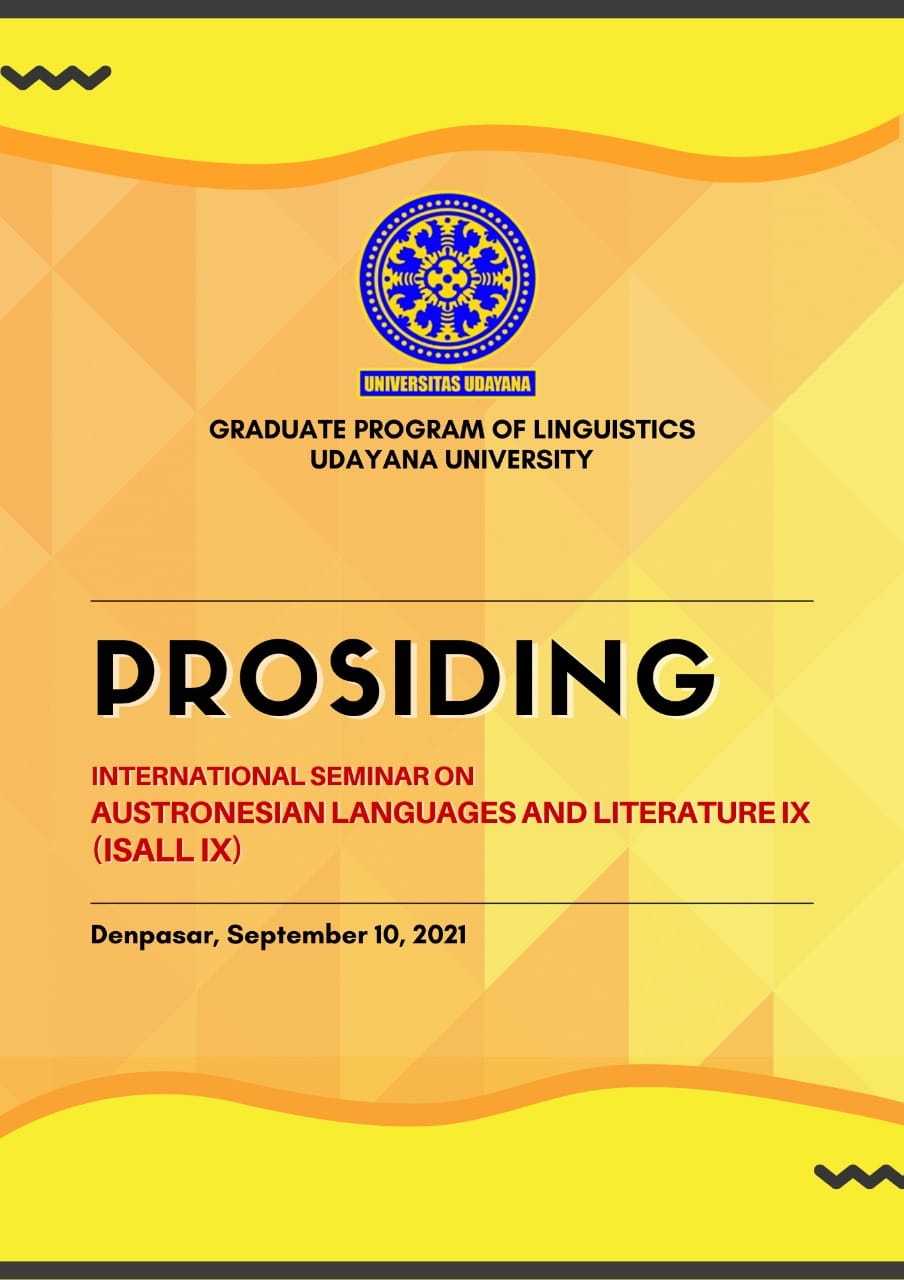Linguistik Lanskap di Museum Lontar Gedong Kirtya
Abstract
Landscape Linguistics (LL) is about how language is represented in public spaces. This study describes the use of language to explain historical objects in the Museum Gedong Kirtya using the LL study. This qualitative research describes the variant language and its function to give information in the Museum Gedong Kirtya. The objects of this study are photos of museum signs and objects labels or exhibit labels. Twenty photos are taken and used for analysis. The photos are classified based on two groups: museum signs and exhibit labels. Twenty photographs were taken and used for analysis. The photos are classified according to two groups: museum signs and exhibit labels. The results shows that the languages ??used were monolingual, bilingual, and multilingual—Balinese, Indonesian, English, and Dutch. Indonesian and English are dominantly used as museum signs and exhibit labels in describing museum historical objects, especially related to the process of making lontar manuscripts. In addition, both languages ??are used to indicate museum signs, for example, the prohibition sign and the welcome sign. The Balinese language is used in the form of Balinese script and as a cultural tradition. Dutch is used for information. The construction of the Gedong Kirtya museum was established during the Dutch government
References
Backhaus, Peter. (2006). Multilingualism in Tokyo: A Look into the Linguistic Landscape. Clevedon: Multi Lingual Matters Ltd.
Bratakesawa, Raden. (1980). Keterangan Candrasengkala. Alih Aksara oleh T.W.K. Hadisoeprapta. Departemen Pendidikan Dan Kebudayaan: Proyek Penerbitan Buku Sastra Indonesia Dan Daerah.
Cenoz, J. and Gorter, D. (2006). Linguistic Landscape and Minority Languages, International Journal of Multilingualism (special issue) 3(1): 67–80. diunduh tanggal 20/08/2021
Duranti, A. 1997. Linguistic Anthropology. Cambridge:CUP
Gorter, Durk. (2006). Linguistic Landscape: New Approach to Multilingualism. Toronto: Multilingual Matters, Ltd.
Kramsch, C. 1998. Language and Culture. Oxford: Oxford University Press.
Mari, Vanessa. (2018). Using the Linguistic Landscape to Bridge Languages. English Teaching Forum, v56 n1 p37-39 diunduh tanggal 20/08/2021
Oktavianus,dkk. (2019). Lanskap Linguistik Nilai Budaya Pada Rumah Makan Minang. Jurnal Mosaik, v19, n1, h.90—108 diunduh tanggal 20/08/2021
Sahril, Syahifuddin, dkk. (2019). Lanskap Linguistik Kota medan: Kajian Onomastika, Semiotika, dan Spasial. Jurnal Medan Makna, v17, n2, h.195—208 diunduh tanggal 20/08/2021
Sudadi. (2018). Sengkalan: Angka Tahun di Balik Ungkapan Jawa. Kemendikbud. Buku Bacaan untuk Anak SMP.
UPTD. Gedong Kirtya. UPTD. Gedong Kirtya. Brosur
Widyanto, Gunawan. (2019). Lanskap Linguistik di Museum Radya Pustaka Surakarta. Prosiding Seminar nasional Linguistik dan Sastra (SEMANTIKS), h.255—262 diunduh tanggal 20/08/2021
Wulansari, Dwi Windah. (2020). Linguistik Lanskap di Bali: Tanda Multilingual dalam Papan Nama Ruang Publik. Jurnal Kredo, v.3, n2, h.420—429 diunduh tanggal 20/08/2021
https://balebengong.id/foto-wisata-sejarah-ke-museum-lontar-gedong-kirtya/ diakses tanggal20/08/2021
https://buleleng.bulelengkab.go.id/informasi/detail/artikel/25-indonesia-miliki-koleksi-lontar-terlengkap-di-dunia diakses tanggal20/08/2021
https://kebudayaan.kemdikbud.go.id/bpcbbali/gedunggedong-kirtya-singaraja-sebagai-situs-cagar-budaya/ diakses tanggal20/08/2021
https://referensi.data.kemdikbud.go.id/tabsK.php?kode_pengelolaan=MS000337 diakses tanggal20/08/2021
https://www.youtube.com/watch?v=ie145D3mQYI diakses tanggal 24/08/2021


